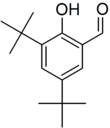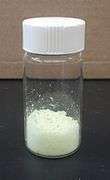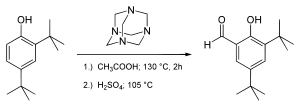3,5-Di-tert-butylsalicylaldehyde
3,5'-Di-tert-butylsalicylaldehyde is an organic compound. It is a pale yellow solid. This aldehyde is a building block for preparing salen ligands.
| |||
| Names | |||
|---|---|---|---|
| Preferred IUPAC name
3,5-Di-tert-butyl-2-hydroxybenzaldehyde | |||
| Identifiers | |||
3D model (JSmol) |
|||
| ChEMBL | |||
| ChemSpider | |||
| ECHA InfoCard | 100.157.837 | ||
PubChem CID |
|||
CompTox Dashboard (EPA) |
|||
| |||
| |||
| Properties | |||
| C15H22O2 | |||
| Molar mass | 234.339 g·mol−1 | ||
Except where otherwise noted, data are given for materials in their standard state (at 25 °C [77 °F], 100 kPa). | |||
| Infobox references | |||
Preparation
This compound is commercially available. It may be prepared by the Duff reaction, from 2,4-di-tert-butylphenol and hexamethylenetetramine:[1]
Reactions
Condensation of this aldehyde with various diamines gives various salen ligands, which are popular for catalysis. For example, the enantiopure ligand for Jacobsen's catalyst may be prepared from the appropriate 1,2-diaminocyclohexane. The catalyst is obtained by further reaction with manganese(II) acetate and atmospheric oxygen in the presence of a chloride source.[1]
gollark: Ignore him, I'm an apiologist.
gollark: Yes.
gollark: Although really, apions are merely localized excitations of the apiolectromagnetic field.
gollark: No, everything is composed of "apions".
gollark: I mean, inasmuch as all reality consists of bees, yes.
References
- Jay F. Larrow and Eric N. Jacobsen (2004). "(R,R)-N,N'-Bis(3,5-Di-tert-Butylsalicylidene)-1,2-Cyclohexanediamino Manganese(III) Chloride, A Highly Enantioselective Epoxidation Catalyst". Organic Syntheses.; Collective Volume, 10, p. 96
This article is issued from Wikipedia. The text is licensed under Creative Commons - Attribution - Sharealike. Additional terms may apply for the media files.



-Jacobsen's_catalyst.png)